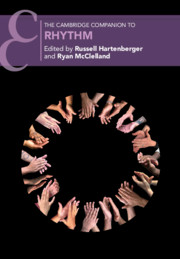Acknowledgments
Many friends and fellow musicians have provided substantial assistance in preparing this volume. In particular, we would like to thank Kate Brett and Eilidh Burrett of Cambridge University Press. Kate encouraged us to pursue the topic of rhythm and contributed valuable advice in the initial stages of the book. As our manuscript wound its way to a finished product, Eilidh gently kept us on track with her sage advice. Several people were helpful to us in the initial stages of this book. Jeff Packman and Danielle Robinson gave advice on the book’s structure and guided us in the direction of authors for specific chapters. Likewise, Tara Browner and Michael Tenzer provided valuable suggestions that were extremely helpful.
From Russell Hartenberger:
I want to thank the sixteen musicians from both Canada and Brazil whose clapping hands appear on the cover of this book. I especially want to thank my wife, Bonnie Sheckter, for her design of the cover as well as her help in creating jpegs, tiffs, photoshopping images, and other technical matters. But most importantly, I want to thank Bonnie for her personal support and encouragement throughout the entire project.
As a percussionist, I have always been intrigued by rhythm, however, several musicians have been particularly significant in opening my mind and ears to the greater world of rhythm. James Kippen has long been my “rhythm whisperer” in giving me advice on both scholarly and performative aspects of rhythm, and I will forever be in his debt for his friendship and mentorship. While I was a graduate student at Wesleyan University, Abraham Adzenyah (Ghana), Ramnad V. Raghavan (South India), Sharda Sahai (North India), Prawotosaputro and Sumarsam (Indonesia) introduced me to the rhythms of their individual cultures and showed me that rhythm and percussion could be the foundation of musical structure and performing ensembles. In 1971, I met composer Steve Reich and began performing with his ensemble. Steve’s imaginative use of rhythm in his compositions demonstrates that rhythm and percussion can be prominent elements in Western music as well as non-Western music. When I asked him about this, Steve said, “… there is an old tradition of this kind of rhythmic counterpoint [in Africa] … and in Bali. And more importantly, percussion and the music generated by percussion as the dominant voice – there’s a tradition for that; you’re not all by yourself. Go, both in terms of the contrapuntal structure of the music and the instrumentation of the music. This is a solid well-trodden path; there’s a path and there’s got to be a future.”
From Ryan McClelland:
My academic interest in the study of rhythm stems from my days as a graduate student at Indiana University, where Gretchen Horlacher, Marianne Kielian-Gilbert, and Frank Samarotto in particular guided my work on rhythm in the music of Johannes Brahms. Since coming to the University of Toronto in 2004, I have had the privilege several times to offer a seminar on rhythm for our graduate students, and I would like to acknowledge the contributions of these students to my understanding of rhythm and to its role in music of various genres, styles, and traditions. I am fortunate to be part of a lively music research environment at the University of Toronto, and I have profited in ways too numerous to articulate from the insights and encouragement of my colleagues. The fact that I can still find some time for research since I have entered into academic administration is a debt I owe to the administrative staff at the University of Toronto, particularly Faculty of Music Registrar Nalayini Balasubramaniam.
Much of my research in rhythm over the past decade has been supported by grants from the Social Sciences and Humanities Research Council of Canada (SSHRC), and I wish to acknowledge that support. I also want to thank my parents for their early and steadfast commitment to my musical education, my childhood piano teachers for stressing excellence in both execution and interpretation, and Jackie for her love, humor, and encouragement.

